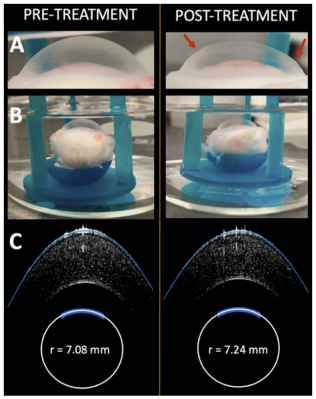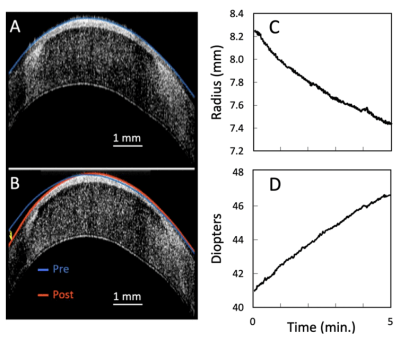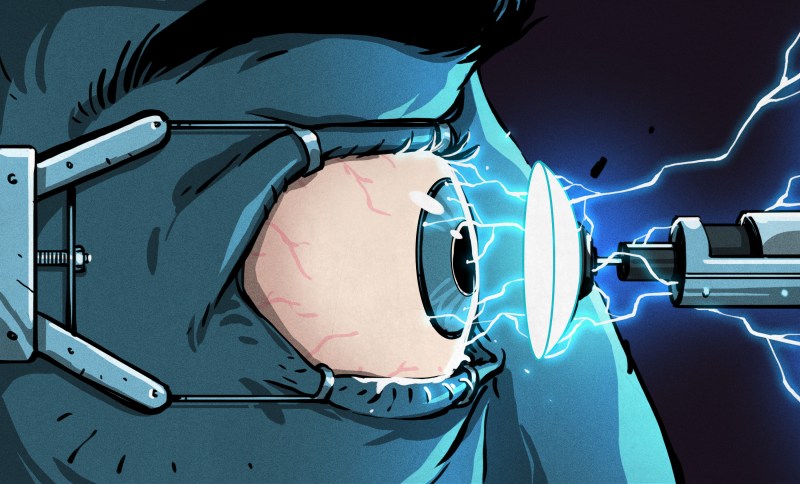Glasses are perhaps the most non-invasive method of vision correction, followed by contact lenses. Each have their drawbacks though, and some seek more permanent solutions in the form of laser eye surgeries like LASIK, aiming to reshape their corneas for better visual clarity. However, these methods often involve cutting into the eye itself, and it hardly gets any more invasive than that.
A new surgical method could have benefits in this regard, allowing correction in a single procedure that requires no lasers and no surgical cutting of the eye itself. The idea is to use electricity to help reshape the eye back towards greater optical performance.
The Eyes Have It

Existing corrective eye surgeries most often aim to fix problems like long-sightedness, short-sightedness, and astigmatism. These issues are generally caused by the shape of the cornea, which works with the lens in the eye to focus light on to the light-sensitive cells in the retina. If the cornea is misshapen, it can be difficult for the eye to focus at close or long ranges, or it can cause visual artifacts in the field of view, depending on the precise nature of the geometry. Technologies like LASIK reshape the cornea for better performance using powerful lasers, but also involve cutting into the cornea. The procedure is thus highly invasive and has a certain recovery time, safety precautions that must be taken afterwards, and some potential side effects. A method for reshaping the eye without cutting into it would thus be ideal to avoid these problems.
Enter the technology of Electromechanical Reshaping (EMR). As per a new paper, researchers at the University of California, Irvine, came across the idea by accident, having been looking into the moldable nature of living tissues. As it turns out, collagen-based tissues like the cornea hold their structure thanks to the attractions between oppositely-charged subcomponents. These structures can be altered with the right techniques. For example, since these tissues are laden with water, applying electricity can change the pH through electrolyzation, altering the attraction between components of the tissue and making them pliable and reformable. Once the electric potential is taken away, the tissues can be restored to their original pH balance, and the structure will hold firm in its new form.

Researchers first tested this technique out on other tissues before looking to the eye. The team were able to use EMR to reshape ears from rabbits, while also being able to make physical changes to scar tissue in pigs. These efforts proved the basic mechanism worked, and that it could have applicability to the cornea itself.
To actually effectively reshape the cornea using this technique, a sort of mold was required. To that end, researchers created a “contact lens” type device out of platinum, which was formed in the desired final shape of the cornea. A rabbit eyeball was used in testing, doused in a saline solution to mimic the eye’s natural environment. The platinum device was pushed on to the eye, and used as an electrode to apply a small electrical potential across the eyeball. This was controlled carefully to precisely change the pH to the region where the eye became remoldable. After a minute, the cornea of the rabbit eyeball had conformed to the shape of the platinum lens. With the electrical potential removed, the pH of the eyeball was returned to normal and the cornea retained the new shape. The technique was trialled on twelve eyeballs, with ten of those treated for a shortsightedness condition, also known as myopia. In the case of the myopic eyeballs, all ten were successfully corrected the cornea, creating improved focusing power that would correspond to better vision in a living patient’s eye.
While the technique is promising, great development will be required before this is a viable method for vision correction in human patients. Researchers will need to figure out how to properly apply the techniques to eyeballs that are still in living patients, with much work to be done with animal studies prior to any attempts to translate the technique to humans. However, it could be that a decade or two in the future, glasses and LASIK will be increasingly less popular compared to a quick zap from the electrochemical eye remoulder. Time will tell.
















Wow! Now THAT’S a hack! :-)
I bet the eyewear industry won’t let this happen …. ;)
yeah for sure. Look at how theyve successfully blocked laser corrective surgery for the last 26 years. /s
I’ve seen it too many times. A plucky entrepreneur discovers a way to bring a better product to the masses and ends up throwing themselves off of a balcony. Just another powerplay by the big LensCrafter mafia.
Know what’s actually terrifying? The induced myopia industry. This is a real thing that some people do to themselves on purpose, so there’s a market.
Stop it or you’ll go blind.
You should really stop once you need glasses.
Hey now, there are people who would actually believe this.
There is also orthokeratology, which consists of nothing but rigid gas-permeable contact lenses the back curvature of which reshapes the cornea. It’s not popular, but it’s been around for decades and offers a non-surgical option that lasts for a few days at a time.
Why!? Nature made them round for good reason!
“round” haha. My friend with severe astigmatism would love this.
If only mine were properly round… they obviously didn’t get the message.
Uh, you know nature messes up right? That’s why some of us wear glasses… obviously you wouldn’t do this for fun on a normally functioning eyeball.
Take a few minutes, read up on eye anatomy and common problems. We’ll wait.
Definitely a good start. I’d like to see more study on how myopia forms. Some studies show dimness of light indoors, not enough bright light in childhood. Window shades in the car etc, sunglasses on toddlers. The “pain” of bright light is the muscles of the eye keeping it in shape.
There’s hope for flop-eared rabbits to get their ears up, maybe better VHF antennae too.
I was myopic by the age of 12, and my eyes were exposed to plenty of light all year. I spent a lot of time outside, and sunglasses were the exception rather than the rule. Neither my parents nor my sister had myopia.
That’s not to say that lack of light can’t contribute to myopia – but it surely isn’t the only cause. Besides, UV light is known to increase the likelihood of cataracts. Given a choice, I’d pick myopia over cataracts. Sadly, I’m stuck with both.
myopia is so much growing… athropin is a start for children
No, not medication at least. If you want children to have better eyesight get them outside in complex engaging environments. Go to parks, get them climbing trees. There primary cause of myopia increases is a lack of exercise. Get them to identify constellations and clouds, in addition to animals like birds.
This should make sense, given there is a growing lack of exercise as it is, and that is causing a similar rise in twisted heath problems.
Humans got a long way by walking, chasing prey, and making tools. Now, for less than a dozen generations suddenly nearly everyone is sedentary most of the time.
Do not look to medication to fix everything.
Ok, no. The pain of bright light is not muscles of the eye at all, where did you hear this? I may be overreacting but this sounds like you think myopia is entirely environmental, it’s not. While that can happen, it’s rare. Humans don’t have perfect vision on average, neither do other animals. It’s a balance your body looses at as you age, and puberty causes more changes to vision than anything else in childhood short of permanent damage.
The idea that window shades in cars and sunglasses are hurting vision is wrong and downright abusive if you follow through. Toddler’s eye pigmentation isn’t as dense as it is for adults, protecting them from bright light is a good thing. This goes doubly for light colours which block less effectively.
You know what actually helps? Lots of variation in near and far distance and detail. This is why being outside is good. Having good lighting decreases eye strain, too much increases it. Entire families can be more or less light sensitive than others.
Do not spread medical misinformation.
Yup, now all they have to tackle is cataracts.
Soon, please.
There is research supporting the use of n-acetyl-l-carnosine eyedrops to prevent, halt the progression of, and in some cases partially reverse cataracts. My impression is that it works, but I don’t have any numbers to back up my impression.
They drill a little hole into the side of your eyeball to the lens sac, emulsify (ultrasonically) the existing cataracted lens, then use a very small vacuum cleaner to suck out the remnants. a replacement lens (plastic) is inserted through a cannula into the lens sac and unrolled into place. I had both eyes done over a 6 week period about 20 years ago. The technology has probably improved since then.
PS: only the eyes are aneasthetised – you’re mainly awake for the half hour op!
I did this on both eyes 3 years ago.
I now have sight of an eagle :-)
My multiangle astigmatism was reduced to just one angle, but due to some restictions my near sightness is reduced from -5.2 and -4.5 to -2 on both eyes.
And by luck i live in sweden, the total cost to me was around 50 usd + new glasses with less correction.
Dang thats amazing resulsts.
My elderly relatives have had theirs done by the NHS, these days you’re in & out in a morning with minimal recovery time.
It would be nice not to need it but it feels like it’s a fairly well solved problem now.
My late father had this done. He doesn’t seem to have minded it at all, but when you’re in close contact with someone and they have bloody stitches IN THEIR EYEBALL it’s a bit unsettling!
Cataracts are being addressed pretty well. Tackling the causes is a current issue. Glaucoma treatments are largely hacks at the moment, and that pressure damages everything.
please, let’s call this what it is – insane-o over-regulation. I’d happily let them try this on one of my eyeballs for a few hundred bucks if I wasn’t the first human. If I was the first….ok maybe $50k…less if they’d done it, and reversed it, on some monkeys. Because we’ve let the state be in charge of parenting us, it’ll now be years of work and money and paperwork, and then we’ll end up paying for all that excessive caution one way or another.
they’ve neither tested on live animals nor developed a way to reverse it. So I hope the hypochlorite doesn’t fry your eyeballs.
And that’s exactly why they are testing on living animals, because if they do so, there will be less risks.
Or you know, they could make you sign a waiver so you can’t sue them if they damage you no matter how bad the damage is. Over corruption and over regulating are yins and yangs of this process.
Assuming the electroplate will be malleable, it shouldn’t cost as much as you think, even with the recoup of the spendings.
ZAP!
Those regulations are written in blood, trauma, life-changing injury, birth defects, etc…
For everyone moaning about over-regulation there is someone decrying Big Pharma and their crimes.
My wife and I had LASIK like 7-8 years ago, top 3 best spend money ever! It is such a huge quality of life improvement. The operation itself was about 15 minutes and not painful, but a little scary. The recovery afterwards can be long and annoying, I had dry eyes for months.
This is a loooong way from being used on humans, but a very interesting approach. Let’s see, if it is viable on living eyes and if it really improves recovery etc compared to existing methods.
what were the other two in the top three?
what a shocking new insight…..
Its nice that they reshape collagen in dead eyes. problem is that this technique will likely harm the important live cells.
Hey, this is Hackaday… Where’s the link to the GitHub project that has the 3D printer job to build one of these‽